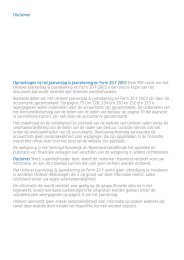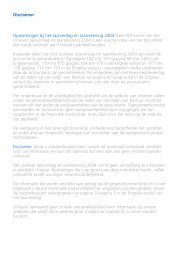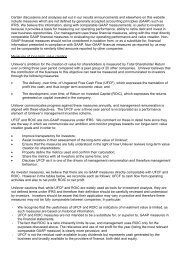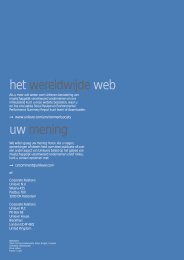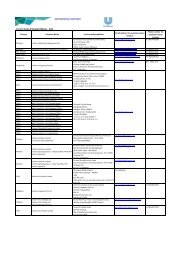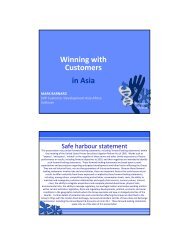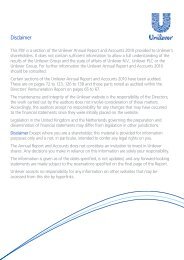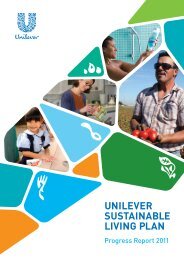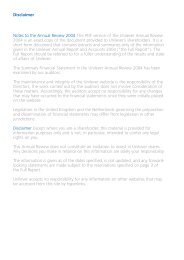Unilever Annual Report & Accounts and Form 20-F 2000
Unilever Annual Report & Accounts and Form 20-F 2000
Unilever Annual Report & Accounts and Form 20-F 2000
- TAGS
- unilever
- annual
- accounts-and-form
- f
Create successful ePaper yourself
Turn your PDF publications into a flip-book with our unique Google optimized e-Paper software.
48<br />
<strong>Unilever</strong> <strong>Annual</strong> <strong>Report</strong> & <strong>Accounts</strong> <strong>and</strong> <strong>Form</strong> <strong>20</strong>-F <strong>20</strong>00 Financial Statements<br />
Accounting information <strong>and</strong> policies<br />
<strong>Unilever</strong> Group<br />
United Kingdom Financial <strong>Report</strong>ing St<strong>and</strong>ard 19 ‘Deferred<br />
tax’ becomes m<strong>and</strong>atory for accounting periods ending on<br />
or after 23 January <strong>20</strong>02 <strong>and</strong> requires that full provision be<br />
made for deferred tax assets <strong>and</strong> liabilities. As indicated<br />
above, <strong>Unilever</strong> already provides fully for deferred tax<br />
balances <strong>and</strong> therefore it is anticipated that the st<strong>and</strong>ard,<br />
together with its disclosure requirements, will be adopted by<br />
<strong>Unilever</strong> for the year ending 31 December <strong>20</strong>01, with no<br />
material impact on reported financial position or results of<br />
operations.<br />
Recent changes in reporting requirements under US GAAP<br />
are discussed on pages 99 <strong>and</strong> 100.<br />
Group companies<br />
Group companies are those companies in whose share<br />
capital NV or PLC holds an interest directly or indirectly,<br />
<strong>and</strong> whose consolidation is required for the accounts to<br />
give a true <strong>and</strong> fair view.<br />
In order that the consolidated accounts should present<br />
a true <strong>and</strong> fair view, it is necessary to differ from the<br />
presentational requirements of the United Kingdom<br />
Companies Act 1985 by including amounts attributable<br />
to both NV <strong>and</strong> PLC shareholders in the capital <strong>and</strong> reserves<br />
shown in the balance sheet. The Companies Act would<br />
require presentation of the capital <strong>and</strong> reserves attributable<br />
to NV <strong>and</strong> PLC shareholders as minority interests in the<br />
respective consolidated accounts of PLC <strong>and</strong> NV. This<br />
presentation would not give a true <strong>and</strong> fair view of the<br />
effect of the Equalisation Agreement, under which the<br />
position of all shareholders is as nearly as possible the<br />
same as if they held shares in a single company.<br />
Net profit <strong>and</strong> profit of the year retained are presented on<br />
a combined basis on page 50, with the net profit attributable<br />
to NV <strong>and</strong> PLC shareholders shown separately. Movements<br />
in profit retained are analysed between those attributable<br />
to NV <strong>and</strong> PLC shareholders in note 22 on page 69.<br />
Foreign currencies<br />
Exchange differences arising in the accounts of individual<br />
companies are dealt with in their respective profit <strong>and</strong> loss<br />
accounts. Those arising on trading transactions are taken<br />
to operating profit; those arising on cash, current investments<br />
<strong>and</strong> borrowings are classified as interest.<br />
In preparing the consolidated accounts, the profit <strong>and</strong> loss<br />
account, the cash flow statement <strong>and</strong> all movements in<br />
assets <strong>and</strong> liabilities are translated at annual average rates<br />
of exchange. The balance sheet, other than the ordinary<br />
share capital of NV <strong>and</strong> PLC, is translated at year-end rates<br />
of exchange. In the case of hyper-inflationary economies,<br />
the accounts are adjusted to remove the influences of<br />
inflation before being translated.<br />
The acquisition balance sheet of Bestfoods was translated at<br />
the exchange rates prevailing at the date of the acquisition<br />
on 4 October <strong>20</strong>00. The results of Bestfoods for the period<br />
following its acquisition have been translated at the average<br />
rates of exchange for that period.<br />
The ordinary share capital of NV <strong>and</strong> PLC is translated at<br />
the rate contained in the Equalisation Agreement of £1 = Fl. 12<br />
(equivalent to €5.445). The difference between this <strong>and</strong> the<br />
value derived by applying the year-end rate of exchange is<br />
taken to other reserves (see note 23 on page 69).<br />
The effects of exchange rate changes during the year on<br />
net assets at the beginning of the year are recorded as a<br />
movement in profit retained, as is the difference between<br />
profit of the year retained at average rates of exchange<br />
<strong>and</strong> at year-end rates of exchange.<br />
Goodwill <strong>and</strong> intangible assets<br />
No value is attributable to internally generated intangible assets.<br />
Goodwill (being the difference between the consideration<br />
paid for new interests in group companies, joint ventures<br />
<strong>and</strong> associated companies <strong>and</strong> the fair value of the Group’s<br />
share of their net assets at the date of acquisition) <strong>and</strong><br />
identifiable intangible assets purchased after 1 January 1998<br />
are capitalised <strong>and</strong> amortised in operating profit over the<br />
period of their expected useful life, up to a maximum of<br />
<strong>20</strong> years. Periods in excess of five years are used only where<br />
the directors are satisfied that the life of these assets will<br />
clearly exceed that period. Goodwill <strong>and</strong> intangible assets<br />
purchased prior to 1 January 1998 were written off in the<br />
year of acquisition as a movement in profits retained.<br />
On disposal of a business acquired prior to 1 January 1998,<br />
purchased goodwill written off on acquisition is reinstated<br />
in arriving at the profit or loss on disposal.<br />
Tangible fixed assets<br />
Tangible fixed assets are stated at cost less depreciation.<br />
Depreciation is provided on a straight-line basis at<br />
percentages of cost based on the expected average useful<br />
lives of the assets. Estimated useful lives by major class of<br />
assets are as follows:<br />
Freehold buildings 33-40 years<br />
(no depreciation on freehold l<strong>and</strong>)<br />
Leasehold l<strong>and</strong> <strong>and</strong> buildings *33-40 years<br />
Plant <strong>and</strong> equipment 3-<strong>20</strong> years<br />
Motor vehicles 3-6 years<br />
*or life of lease if less than 33 years<br />
Current cost information is given in note 10 on page 58.<br />
Fixed assets are subject to review for impairment in<br />
accordance with United Kingdom Financial <strong>Report</strong>ing<br />
St<strong>and</strong>ard 11 ‘Impairment of Fixed Assets <strong>and</strong> Goodwill’, <strong>and</strong><br />
US SFAS 121. Any impairment in the value of such fixed<br />
assets is charged to the profit <strong>and</strong> loss account as it arises.<br />
Fixed investments<br />
Joint ventures are undertakings in which the Group has<br />
a long-term participating interest <strong>and</strong> which are jointly<br />
controlled by the Group <strong>and</strong> one or more other parties.<br />
Associated companies are undertakings in which the<br />
Group has a participating interest <strong>and</strong> is able to exercise<br />
significant influence.



